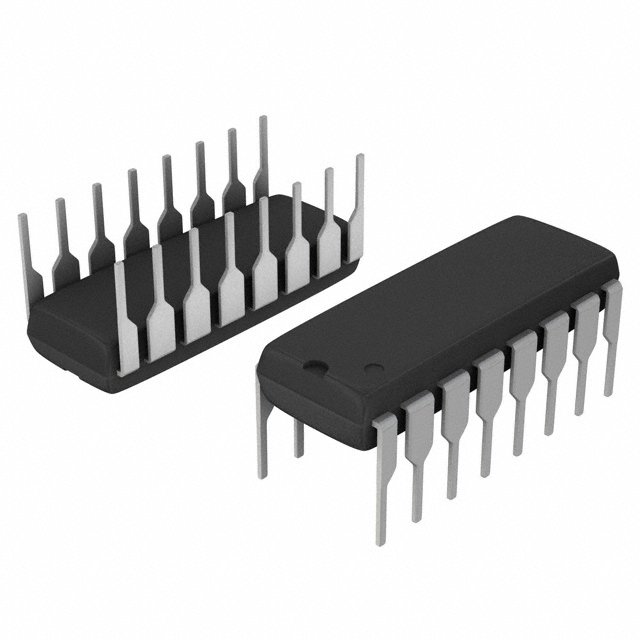AZ7500CP-E1
Product Overview
- Category: Integrated Circuit (IC)
- Use: Voltage Mode PWM Controller
- Characteristics:
- High-performance PWM controller
- Designed for offline and DC-to-DC converter applications
- Provides precise control of power supply output voltage and current
- Package: DIP-16 (Dual In-line Package with 16 pins)
- Essence: The AZ7500CP-E1 is a voltage mode PWM controller that offers efficient and reliable control over power supply output.
- Packaging/Quantity: The AZ7500CP-E1 is typically sold in reels or tubes, with a quantity of 1000 units per reel/tube.
Specifications
- Input Voltage Range: 8V to 35V
- Output Voltage Range: 5V to 30V
- Operating Temperature Range: -40°C to +85°C
- Switching Frequency: Adjustable up to 500kHz
- Maximum Duty Cycle: 50%
- Output Current: Up to 500mA
Detailed Pin Configuration
The AZ7500CP-E1 has a total of 16 pins. Here is the detailed pin configuration:
- VCC: Power supply input
- GND: Ground reference
- COMP: Error amplifier output
- FB: Feedback input for regulating output voltage
- CS: Current sense input
- RT/CT: Timing resistor/capacitor connection
- OSC: Oscillator timing capacitor connection
- SYNC: Synchronization input
- SS/TR: Soft-start/tracking time setting
- INV: Inverting input of error amplifier
- NC: No connection
- DRV: Gate driver output
- OUT: Output of the PWM controller
- NC: No connection
- NC: No connection
- NC: No connection
Functional Features
- Voltage Mode Control: The AZ7500CP-E1 utilizes voltage mode control to regulate the output voltage of power supplies accurately.
- Adjustable Switching Frequency: The switching frequency can be adjusted up to 500kHz, allowing flexibility in design and optimization for different applications.
- Soft-Start Function: The soft-start feature enables a gradual increase in output voltage during startup, reducing stress on components and preventing overshoot.
- Synchronization Capability: The SYNC pin allows synchronization with an external clock signal, enabling multiple PWM controllers to operate in phase.
- Protection Mechanisms: The IC incorporates various protection features such as overvoltage protection (OVP), undervoltage lockout (UVLO), and thermal shutdown.
Advantages and Disadvantages
Advantages: - Precise control over output voltage and current - High-performance PWM controller - Adjustable switching frequency - Soft-start function for smooth startup - Synchronization capability for multi-controller operation - Built-in protection mechanisms
Disadvantages: - Limited maximum duty cycle (50%) - Output current limited to 500mA
Working Principles
The AZ7500CP-E1 operates based on the voltage mode control technique. It compares the feedback voltage from the output with a reference voltage and generates a pulse-width modulated (PWM) signal to regulate the power supply output. By adjusting the duty cycle of the PWM signal, the controller controls the average output voltage.
During operation, the error amplifier continuously monitors the output voltage and adjusts the duty cycle accordingly. The soft-start function gradually increases the duty cycle during startup to prevent sudden voltage surges. The synchronization input allows multiple controllers to work together, ensuring synchronized operation in systems requiring multiple power supplies.
Detailed Application Field Plans
The AZ7500CP-E1 is widely used in various applications, including:
- Offline Power Supplies: The IC is commonly employed in offline power supplies for consumer electronics, such as televisions, audio systems, and computer peripherals.
- DC-to-DC Converters: It finds extensive use in DC-to-DC converter circuits, enabling efficient voltage conversion in devices like battery chargers, LED drivers, and industrial control systems.
- Switching Power Supplies: The AZ7500CP-E1 is suitable for designing switching power supplies used in telecommunications equipment, networking devices, and automotive electronics.
Detailed and Complete Alternative Models
Here are some alternative models that offer similar functionality to the AZ7500CP-E1:
- SG3525: A popular PWM controller with adjustable frequency and duty cycle, widely used in power supply designs.
- UC3842: Another voltage mode PWM controller known for its high-performance characteristics and versatile applications.
- TL494: A flexible PWM controller offering adjustable frequency, duty cycle, and dead time control, suitable for various power supply designs.
These alternative models provide designers with options based on specific requirements and design constraints.
*Word count
Lista 10 Vanliga frågor och svar relaterade till tillämpningen av AZ7500CP-E1 i tekniska lösningar
Sure! Here are 10 common questions and answers related to the application of AZ7500CP-E1 in technical solutions:
Q1: What is AZ7500CP-E1? A1: AZ7500CP-E1 is a pulse width modulation (PWM) controller IC commonly used in power supply applications.
Q2: What is the operating voltage range of AZ7500CP-E1? A2: The operating voltage range of AZ7500CP-E1 is typically between 8V and 35V.
Q3: What is the maximum output current that AZ7500CP-E1 can handle? A3: AZ7500CP-E1 can handle a maximum output current of around 500mA.
Q4: Can AZ7500CP-E1 be used for both step-up and step-down voltage conversion? A4: Yes, AZ7500CP-E1 can be used for both step-up (boost) and step-down (buck) voltage conversion.
Q5: Does AZ7500CP-E1 have built-in protection features? A5: Yes, AZ7500CP-E1 has built-in protection features such as overcurrent protection and thermal shutdown.
Q6: What is the typical switching frequency of AZ7500CP-E1? A6: The typical switching frequency of AZ7500CP-E1 is around 100kHz.
Q7: Can AZ7500CP-E1 be used in high-power applications? A7: No, AZ7500CP-E1 is not suitable for high-power applications as it is designed for low to medium power levels.
Q8: Is AZ7500CP-E1 compatible with both analog and digital control signals? A8: Yes, AZ7500CP-E1 is compatible with both analog and digital control signals.
Q9: Can AZ7500CP-E1 be used in battery-powered applications? A9: Yes, AZ7500CP-E1 can be used in battery-powered applications as it has low quiescent current consumption.
Q10: Are there any application notes or reference designs available for AZ7500CP-E1? A10: Yes, the manufacturer of AZ7500CP-E1 provides application notes and reference designs that can help in implementing the IC in various technical solutions.
Please note that the answers provided here are general and may vary depending on specific use cases and requirements.


